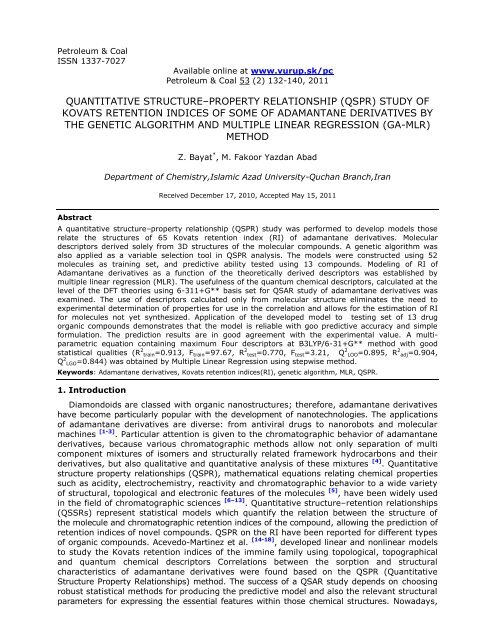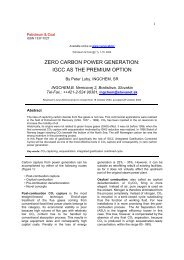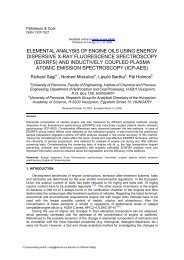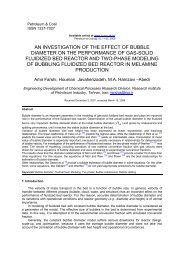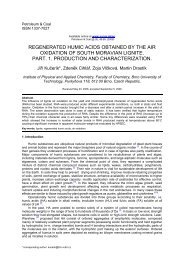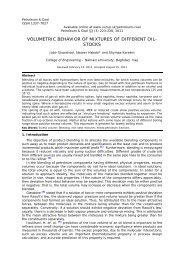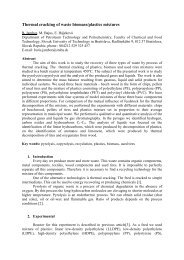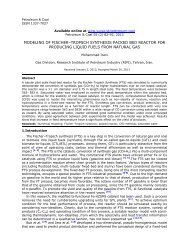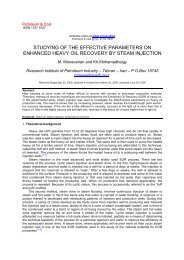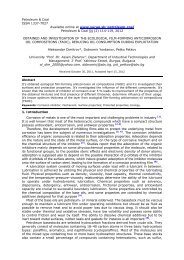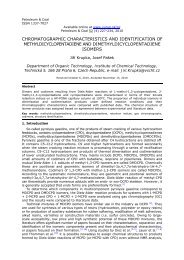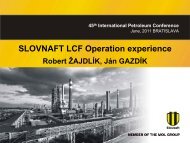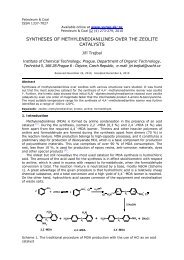Quantitative structure–Property relationship (QSPR) study of Kovats ...
Quantitative structure–Property relationship (QSPR) study of Kovats ...
Quantitative structure–Property relationship (QSPR) study of Kovats ...
- No tags were found...
Create successful ePaper yourself
Turn your PDF publications into a flip-book with our unique Google optimized e-Paper software.
genetic algorithms (GA) are well known as interesting and widely used methods for variableselection [19] . In a QSAR <strong>study</strong> the model must be validated for its predictive value before itcan be used to predict the response <strong>of</strong> additional chemicals. Validating <strong>QSPR</strong> with externaldata (i.e. data not used in the model development), although demanding, is the best methodfor validation [20–21] . In the present work, the data splitting was performed randomly andwas confirmed by the factor spaces <strong>of</strong> the descriptors. Finally, the accuracy <strong>of</strong> the proposedmodel was illustrated using the following: leave one out, bootstrapping and external test set,cross-validations and Y-randomization techniques.2. Methodology2.1 Data setZ. Bayat, M. Fakoor, Y. Abad/Petroleum & Coal 53(2) 132-140, 2011 133The property data used in this <strong>study</strong> are the <strong>Kovats</strong> retention index (RI) <strong>of</strong> <strong>of</strong> the set <strong>of</strong>65 Adamantane derivatives [22] . The data set was randomly divided into two subsets: thetraining set containing 52 compounds (80%) and the test set containing 13 compounds(20%). The training set was used to build a regression model, and the test set was used toevaluate the predictive ability <strong>of</strong> the model obtained. The activity data for the complete set<strong>of</strong> compounds are presented in Table 1.To derive QSAR models, an appropriate representation<strong>of</strong> the chemical structure is necessary. For this purpose, descriptors <strong>of</strong> the structure arecommonly used.Table 1. Experimental values <strong>of</strong> RI for adamantane derivatives training setName Exp. Pred Ref.adamantane 1118 1131 221 3 dimethyl adamantine 1151 1198 221-fluoro adamantine 1159 1259 222-methylene adamantine 1160 1172 221,3,5 -trimethyl adamantine 1163 1226 222-methyl adamantine 1196 1219 221 2-dimethyl adamantine 1236 1231 221-ethyl adamantine 1260 1221 222 2-dimethyl adamantine 1269 1274 221-ethyl-3,5 di methyl adamantine 1279 1291 223-ethyl-1-adamantanol 1283 1348 223-methyl-1-adamantanol 1283 1290 223 5-dimethyl-1-adamantanol 1295 1290 221-chloroadamantane 1298 1295 223,5,7-trimethyl-1-adamantanol 1304 1318 222-adamantanon 1320 1322 222-chloro adamantine 1342 1342 221-propyl adamantine 1347 1298 222-methyl-2-adamantanol 1348 1397 222-isopropyl adamantine 1349 1391 222-propyl adamantine 1371 1391 221-bromo adamantine 1382 1376 221-hydroxy methyl adamantine 1402 1393 221-chloromethyladamantane 1404 1367 222-isobuthyl adamantine 1416 1383 223-ethyl-5,7-dimethyl -1-adamantanol 1421 1395 223-5 dimethyl 1 hydroxy methyl adamantine 1425 1440 225-7-dimethyl1-3 adamantandiol1. 1438 1458 221-buthyl adamantine 1443 1383 22methyl-(1-adamanthyl) ketone 1443 1407 22methyl-(2-adamanthyl)ketone 1445 1387 222-ethyl-2-adamantanol 1446 1445 222-buthyl adamantine 1465 1416 22adamantane-2-carboxylic acid methyl ester 1467 1464 22
Name Exp. Pred Ref.methyl ester <strong>of</strong> 3,5 di methyl adamantane1-carboxilic acid 1467 1510 221-bromomethyl adamantine 1488 1494 222-methyl-1-hydroxy methyl adamantine 1490 1438 223-isopropyl-1-adamantanol 1506 1406 22adamantane -1-carboxylic acid ethyl ester 1508 1459 22Methyl esters <strong>of</strong> 2-methyl adamantane -1-carboxylic acid 1512 1520 22Adamantane-2-carboxylic acid ethyl ester 1529 1557 22ethyl-(1-adamanthyl)ketone 1529 1491 22adamantane-1-carboxylic acid iso propyl ester 1532 1585 22adamantane-1-carboxylic acid tert-buthyl ester 1556 1679 222-isobuthyl-2-adamantanol 1570 1547 22Methyl ester <strong>of</strong> -3-ethyl adamantane -1-carboxylic asid 1579 1544 223-buthyy-1-adamantanol 1595 1528 22esters <strong>of</strong> adamantane 1-carboxylic acid propyl ester 1603 1630 222-buthyl-2-adamantanol 1620 1596 22adamantane -1-carboxylic acid sec-buthyl ester 1631 1632 22adamantane -1-carboxylic acid iso buthyl ester 1658 1596 22di methyl ester <strong>of</strong> 5,7-di methyl adamantane -1-3 di carboxylic acid 1769 1809 222.2 Molecular descriptor generationZ. Bayat, M. Fakoor, Y. Abad/Petroleum & Coal 53(2) 132-140, 2011 134To derive QSAR models, an appropriate representation <strong>of</strong> the chemical structure is necessary.For this purpose, descriptors <strong>of</strong> the structure are commonly used. These descriptors are generallyunderstood as being any term, index or parameter conveying structure information. Commonlyused descriptors in the QSAR analysis are presented in Table 2.Table 2. Experimental values <strong>of</strong> RI for adamantane derivatives test setName EXP Test Ref.1-methyladamantane 1137 1148 222-fluoro adamantine 1182 1281 221-adamantanol 1268 1374 222-ethyl adamantine 1284 1269 222-adamantanol 1329 1403 221-isopropyl adamantine 1358 1284 223 5-dimethyl -1-bromo adamantine 1401 1433 222-bromoadamantane 1426 1464 22esters <strong>of</strong> adamantane1-carboxylic acid methyl ester 1449 1444 223-propyl-1-adamantanol 1495 1447 222-propyl-2-adamantanol 1526 1474 223-(1-adamanthyl)pentane 1559 1430 22propyl-(1-adamanthyl) ketone 1609 1538 22Some <strong>of</strong> the descriptors are obtained directly from the chemical structure, e. g. constitutional,geometrical, and topological descriptors. Other chemical and physicochemical propertieswere determined by the chemical structure (lipophilicity, hydrophilicity descriptors, electronicdescriptors, energies <strong>of</strong> interaction). In this work, we used Gaussian 03 for ab initio calculations.DFT method at 6-31+G** were applied for optimization <strong>of</strong> adamantane derivatives andcalculation <strong>of</strong> many <strong>of</strong> the descriptors. At first Adamantane derivatives were built by Hyperchems<strong>of</strong>tware and some o the descriptors such as surface area, hydration energy, and refractivitywere calculated through it. The rest <strong>of</strong> the descriptors were obtained <strong>of</strong> Gaussian calculations.A large number <strong>of</strong> descriptors were calculated by Gaussian package and Hyperchem s<strong>of</strong>tware.One way to avoid data redundancy is to exclude descriptors that are highly intercorrelatedwith each other before performing statistical analysis. Reduced multi co-linearity and redundancyin the data will facilitate selection <strong>of</strong> relevant variables and models for the investigated endpoint.Variable-selection for the QSAR modeling was carried out by stepwise linear regressionmethod. A stepwise technique was employed that only one parameter at a time was addedto a model and always in the order <strong>of</strong> most significant to least significant in terms <strong>of</strong> F-test
values. Statistical parameters were calculated subsequently for each step in the process, sothe significance <strong>of</strong> the added parameter could be verified. The goodness <strong>of</strong> the correlation istested by the regression coefficient (R 2 ), the F-test and the standard error <strong>of</strong> the estimate(SEE). The test and the level <strong>of</strong> significance, as well as the confidence limits <strong>of</strong> the regressioncoefficient, are also reported. The squared correlation coefficient, R 2 , is a measure <strong>of</strong> the fit<strong>of</strong> the regression model. Correspondingly, it represents the part <strong>of</strong> the variation in the observed(experimental) data that is explained by the model.2.3 Genetic algorithmGenetic algorithms (GAs) are governed by biological evolution rules [23] . These are stochasticoptimization methods that have been inspired by evolutionary principles. The distinctiveaspect <strong>of</strong> a GA is that it investigates many possible solutions simultaneously, each <strong>of</strong> whichexplores a different region in the parameter <strong>of</strong> space [24] . To select the most relevant descriptors,the evolution <strong>of</strong> the population was simulated [25-27] . The first generation population wasrandomly selected; each individual member in the population was defined by a chromosome<strong>of</strong> binary values and represented a subset <strong>of</strong> descriptors. The number <strong>of</strong> the genes at eachchromosome was equal to the number <strong>of</strong> the descriptors. A gene was given the value <strong>of</strong> 1, ifits corresponding descriptor was included in the subset; otherwise, it was given the value <strong>of</strong>zero. The number <strong>of</strong> the genes with the value <strong>of</strong> 1 was kept relatively low to have a smallsubset <strong>of</strong> descriptors [28] . As a result, the probability <strong>of</strong> generating 0 for a gene was set greater(at least 60 %) than the value <strong>of</strong> 1. The operators used here were the crossover and mutationoperators. The application probability <strong>of</strong> these operators was varied linearly with a generationrenewal (0–0.1 % for mutation and 60–90 % for crossover). The population size was variedbetween 50 and 250 for the different GA runs. For a typical run, the evolution <strong>of</strong> the generationwas stopped when 90% <strong>of</strong> the generations took the same fitness. The fitness function usedhere was the leave-one-out cross-validated correlation coefficient, Q 2 LOO. The GA programwas written in Matlab 6.5 [29] .3. Results and discussionZ. Bayat, M. Fakoor, Y. Abad/Petroleum & Coal 53(2) 132-140, 2011 135In a QSAR <strong>study</strong>, generally, the quality <strong>of</strong> a model is expressed by its fitting ability andprediction ability, and <strong>of</strong> these the prediction ability is the more important. In order to buildand test the model, a data set <strong>of</strong> 65 compounds was separated into a training set <strong>of</strong> 52compounds, which were used to build the model and a test set <strong>of</strong> 13 compounds, whichwere applied to test the built model. With the selected descriptors, we have built a linearmodel using the training set data, and the following equation was obtained:RI = -4.45754 (±1.161528) σ 9 -80.1305 (±11.72555) ΔG CYCLO + 5.768715 (±0.292762) M- 121.607 (±42.44063) MC 9 + 0.072961 (±0.015957) HF +177.4361 (±112.5648)(B3LYP/6-31+G**)R 2 train=0.914 F train =97.674 R 2 test=0.770 F test = 3.214 R 2 adj=0.904Q 2 LOO=0.895 Q 2 LGO= 0.84451 N train = 52, N test = 13In this equation, N is the number <strong>of</strong> compounds, R 2 is the squared correlation coefficient,Q 2 LOO and Q 2 LGO are the squared cross-validation coefficients for leave one out, bootstrappingand external test set respectively, RMSE is the root mean square error and F is the Fisher Fstatistic. The figures in parentheses are the standard deviations. The built model was usedto predict the test set data and the prediction results are given in Table 1. and the test resultsare given in Table 3. As can be seen from Table 1, the calculated values for the RI are ingood agreement with those <strong>of</strong> the experimental values. The predicted values for RI for thecompounds in the training and test sets using equation RI were plotted against the experimentalRI values in Figure 1.and the comparison between Retention Index using prediction and theexperimental .A plot <strong>of</strong> the residual for the predicted values <strong>of</strong> RI for both the training andtest sets against the experimental RI values are shown in Figure 2. As can be seen the modeldid not show any proportional and systematic error, because the propagation <strong>of</strong> the residualson both sides <strong>of</strong> zero are random. The real usefulness <strong>of</strong> QSAR models is not just their abilityto reproduce known data, verified by their fitting power (R 2 ), but is mainly their potential forpredictive application. For this reason the model calculations were performed by maximizing
Z. Bayat, M. Fakoor, Y. Abad/Petroleum & Coal 53(2) 132-140, 2011 136the explained variance in prediction, verified by the leave-one-out cross-validated correlationcoefficient,Q 2 LOO maximizing the explained variance in prediction, verified by the leave-oneoutcross-validated correlation coefficient, Q 2 LOO. To avoid the danger <strong>of</strong> over fitting and thepossibility <strong>of</strong> overestimating the model predictivity by using Q 2 LOO procedure, as is stronglyrecommended for QSAR modeling. The Q 2 LOO and Q 2 GLO for the MLR model are shown inEquation RI. This indicates that the obtained regression model has a good internal andexternal predictive power.Table 3. The calculated descriptors used in this <strong>study</strong>.Descriptors Symbol Abbreviatio Descriptors Symbol AbbreviationnMolecular Dipole MDPdifference between E GAPMomentLUMO and HOMOMolecularMPHardnessΗPolarizability[ η=1/2(HOMO+LUMO)]Natural Population NPAS<strong>of</strong>tness ( S=1/ η SQuantumchemicalAnalysisElectrostaticEPQuantumchemical)Electro negativity Χdescriptors Potential0descriptors [χ= -1/2 (HOMO–LUMO)]Highest Occupied HOMOEl Electro philicity ΩMolecular Orbital(ω=χ 2 /2 η )LowestLUMO Mullikenl Chargeg MCUnoccupiedMolecular OrbitalPartitionLog PMolecule surface SACoefficientareaChemicalpropertiesMass M ChemicalpropertiesHydration Energy HEMolecule volume V Refractivity REFFig.1. The predicted versus the experimentalRI by MLRFig. 2. The residual versus the experimental LogPby GA-MLR. (See colour version <strong>of</strong> this figureonline at www.informahealthcare.com/enz)Also, in order to assess the robustness <strong>of</strong> the model, the Y-randomization test was applied inthis <strong>study</strong>. The dependent variable vector (RI) was randomly shuffled and The new QSARmodels (after several repetitions) would be expected to have low R 2 and Q 2 LOO values (Table 4).If the opposite happens then an acceptable QSAR model cannot be obtained for the specificmodeling method and data.
Table 4. The R 2 train and Q 2 LOO values after several Y-randomization testsNO R 2 train Q 2 LOO1 0.1045 0.03122 0.000022 0.09763 0.0939 0.06144 0.0042 0.12825 0.0457 0.05706 0.0340 0.19277 0.0060 0.14428 0.2991 0.01259 0.0175 0.170010 0.0251 0.0608Z. Bayat, M. Fakoor, Y. Abad/Petroleum & Coal 53(2) 132-140, 2011 137The MLR analysis was employed to derive the QSAR models for different adamantanederivatives. MLR and correlation analyses were carried out by the statistics s<strong>of</strong>tware SPSS(Table 5).Table 5. The correlation coefficient existing between the variables used in MLR with B3lyp/6-31+G** method.HF MC 9 M ΔG CYCLO σ 9HF 1 0 0 0 0MC 9 0.048869 1 0 0 0M 0.39506 0.245901 1 0 0ΔG CYCLO 0.099875 0.22142 0.226936 1 0σ 9 0.17506 0.485565 0.070032 0.04617 1Fig. 3. The comparison between properties (RI) using experimental and predictionSeries 1: Values <strong>of</strong> log P were obtained by using prediction. Series 2: Values <strong>of</strong> log P wereobtained by using experimental methods.3.1. Interpretation <strong>of</strong> descriptorsSThe <strong>QSPR</strong> developed indicated that Nuclear magnetic Resonance (σ 9 ), free energy solvation(ΔG CYCLO ), mulliken charge (MC), Hartee-fuck energy (HF) compound <strong>Kovats</strong> retention index.Positive values in the regression coefficients indicate that the indicated descriptor contributespositively to the value <strong>of</strong> RI, whereas negative values indicate that the greater the value <strong>of</strong>the descriptor the lower the value <strong>of</strong> RI. In other words, increasing the σ 9, ΔG CYCLO and MC willdecrease RI and increasing the HF and M increases extent <strong>of</strong> RI <strong>of</strong> the adamantane derivatives.The standardized regression coefficient reveals the significance <strong>of</strong> an individual descriptorpresented in the regression model.
4. ConclusionIn this article, a QSAR <strong>study</strong> <strong>of</strong> 65 adamantane derivatives was performed based on thetheoretical molecular descriptors calculated by the GAUSSIAN s<strong>of</strong>tware and selected. The builtmodel was assessed comprehensively (internal and external validation) and all the validationsindicated that the <strong>QSPR</strong> model built was robust and satisfactory, and that the selecteddescriptors could account for the structural features responsible for the adamantane derivativesproperty <strong>of</strong> the compounds. The <strong>QSPR</strong> model developed in this <strong>study</strong> can provide a usefultool to predict the RI <strong>of</strong> new compounds and also to design new compounds with high RI.ReferencesZ. Bayat, M. Fakoor, Y. Abad/Petroleum & Coal 53(2) 132-140, 2011 138[1] Janssens S, Beyaert R.: Functional diversity and regulation <strong>of</strong> different interleukin-1receptor-associated kinase (IRAK) fami members, Mol. Cell. 2003;11:293–302.[2] Li S, Strelow A, Fontana EJ, Wesche H. IRAK-4: A novel member <strong>of</strong> the IRAK familywith the properties <strong>of</strong> an IRAK-kinase, Proc. Natl. Acad. Sci. USA 2002;99:5567–5572.[3] Medvedev AE, Lentschat A, Kuhns DB, Blanco JC, Salkowski C, Zhang S, Arditi M,Gallin JI, Vogel SN.: Distinct mutations in IRAK-4 confer hyporesponsiveness tolipopolysaccharide and interleukin-1 in a patient with recurrent bacterial infections, J.Exp. Med. 2003;198:521–531.[4] Picard C, Puel A, Bonnet M, Ku CL, Bustamante J, Yang K, Soudais C, Dupuis S,Feinberg J, Fieschi C, Elbim C, Hitchcock R, Lammas D, Davies G, Al- Ghonaium A, Al-Rayes H, Al-Jumaah S, Al-Hajjar S, Al-Mohsen IZ, Frayha HH, Rucker R, Hawn TR,Aderem A, Tufenkeji H, BHaraguchi S, Day NK, Good RA, Gougerot-Pocidalo MA,Cassanova JL.: Pyogenic bacterial infections in humans with IRAK-4 deficiency,Science 2003;299:2076–2079.[5] Li X.: IRAK4 in TLR/IL-1R signaling: possible clinical applications, Eur. J. Immunol.2008;38:614–618.[6] Buckley GM, Ceska TA, Fraser JL, Gowers L, Groom CR, Higueruelo AP, Jenkins K,Mack SR, Morgan T, Parry DM, Pitt WR, Rausch O, Richard MD, Sabin V.: IRAK-4inhibitors. Part II: A structure-based assessment <strong>of</strong> imidazo[1,2-a]pyridine binding.Bioorg. Med. Chem. Lett., 2008;18:3291–3295.[7] Buckley GM, Fosbeary R, Fraser JL, Gowers L, Higueruelo AP, James LA, Jenkins K,Mack SR, Morgan T, Parry DM, Pitt WR, Rausch O, Richard MD, Sabin V.: IRAK-4inhibitors. Part III: A series <strong>of</strong> imidazo[1,2-a]pyridines, Bioorg. Med. Chem. Lett.2008;18:3656–3660.[8] Buckley GM, Gowers L, Higueruelo AP, Jenkins K, Mack SR, Morgan T, Parry DM, PittWR, Rausch O, Richard MD, Sabin V, Fraser JL.: IRAK-4 inhibitors. Part 1: a series <strong>of</strong>amides, Bioorg. Med. Chem. Lett., 2008;18:3211–3214.[9] Sammes PG, Taylor JB.: Comprehensive Medicinal Chemistry. Oxford, PergamonPress, 1990:766.[10] Riahi S, Pourbasheer E, Dinarvand R, Ganjali MR, Norouzi P.: <strong>Quantitative</strong> structureactivity<strong>relationship</strong> <strong>study</strong> on the anti-HIV-1 activity <strong>of</strong> novel 6-naphthylthio HEPTanalogs, Chem. Biol. Drug. Des., 2008;74:165–172.[11] Riahi S, Pourbasheer E, Ganjali MR, Norouzi P.: Investigation <strong>of</strong> different linear andnonlinear chemometric methods for modeling <strong>of</strong> retention index <strong>of</strong> essential oilcomponents: Concerns to support vector machine, J. Hazard. Mater. 2009;166:853–859.[12] Riahi S, Pourbasheer E, Ganjali MR, Norouzi P.: Support vector machinebasedquantitative structure-activity <strong>relationship</strong> <strong>study</strong> <strong>of</strong> cholesteryl ester transfer proteininhibitors, Chem. Biol. Drug. Des., 2009;73:558–571.[13] Depczynski U, Frost VJ, Molt K.: Genetic algorithms applied to the selection <strong>of</strong> factorsin principal component regression, Anal. Chim. Acta, 2000;420:217.[14] Alsberg BK, Marchand-Geneste N, King RD.: A new 3D molecular structurerepresentation using quantum topology with application to structureproperty<strong>relationship</strong>s, Chemometr. Intel. Lab., 2000;54:75–91.[15] Jouanrimbaud D, Massart DL, Leardi R, Denoord OE.: Genetic algorithms as a tool forwavelength selection in multivariate calibration, Anal. Chem., 1995;67:4295–4301.
Z. Bayat, M. Fakoor, Y. Abad/Petroleum & Coal 53(2) 132-140, 2011 139[16] Riahi S, Ganjali MR, E Pourbasheer, Divsar F, Norouzi P, Chaloosi M.: Developmentand validation <strong>of</strong> a rapid chemometrics-assisted spectrophotometry and liquidchromatography methods for the simultaneous determination <strong>of</strong> the phenylalanine,tryptophan and tyrosine in the pharmaceutical products, Curr. Pharm. Anal.,2008;4:231–237.[17] Riahi S, Ganjali MR, Pourbasheer E, Norouzi P.: QSRR <strong>study</strong> <strong>of</strong> GC retention indices <strong>of</strong>essential-oil compounds by multiple linear regression with a genetic algorithm,Chromatographia, 2008;67:917–922.[18] Riahi S, Pourbasheer E, Ganjali MR, Norouzi P, Zeraatkar Moghaddam A.: <strong>QSPR</strong> <strong>study</strong><strong>of</strong> the distribution coefficient property for hydantoin and 5-arylidene derivatives. Agenetic algorithm application for the variable selection in the MLR and PLS methods, J.Chin. Chem. Soc., 2008;55:1086–1093.[19] Riahi S, Ganjali MR, Moghaddam AB, Pourbasheer E, Norouzi P.: Development <strong>of</strong> anew combined chemometrics method, applied in the simultaneous voltammetricdetermination <strong>of</strong> cinnamic acid and 3, 4-dihydroxy benzoic acid, Curr. Anal. Chem.,2009;5:42–47.[20] Tropsha A, Gramatica P, Gombar VK.: The importance <strong>of</strong> being earnest: validation isthe absolute essential for successful application and interpretation <strong>of</strong> <strong>QSPR</strong> models,QSAR Comb. Sci., 2003;22:69–77.[21] Riahi S, Ganjali MR, Norouzi P, Jafari F.: Application <strong>of</strong> GA-MLR, GA-PLS and the DFTquantum mechanical (QM) calculations for the prediction <strong>of</strong> the selectivity coefficients<strong>of</strong> a histamine-selective electrode, Sens. Actuators, B 2008;132:13–19.[22] Burkhard, J., Vais, J., Vodicka L. and Landa S.: Adamantane and its derivatives. XVI.The gas chromatographic characterization <strong>of</strong> adamantane derivatives, Journal <strong>of</strong>Chromatography. Chrom. 4057.[23] Holland H.: Adaption in Natural and Artificial Systems. Ann Arbor, MI: The University<strong>of</strong> Michigan,1975;342–375.[24] Cartwright HM.: Applications <strong>of</strong> Artificial Intelligence in Chemistry. Oxford: OxfordUniversity, 1993;760–765.[25] Hunger J, Huttner G.: Optimization and analysis <strong>of</strong> force field parameters bycombination <strong>of</strong> genetic algorithms and neural networks, J. Comput. Chem.1999;20:455–471.[26] Ahmad S, Gromiha MM.: Design and training <strong>of</strong> a neural network for predicting thesolvent accessibility <strong>of</strong> proteins, J. Comput. Chem. 2003; 24:1313–1320.[27] Waller CL, Bradley MP.: Development and validation <strong>of</strong> a novelb variable selectiontechnique with application to multidimensional quantitative structure-activity<strong>relationship</strong> studies, J. Chem. Inf. Comput. Sci. 1999;39:345–355.[28] Aires-de-Sousa J, Hemmer MC, Casteiger J.: Prediction <strong>of</strong> H-1 NMR chemical shiftsusing neural networks, Anal. Chem. 2002;74:80–90.[29] The Mathworks. Genetic Algorithm and Direct Search Toolbox Users Guide. Massachusetts:MathWorks, 2002;50–65.


